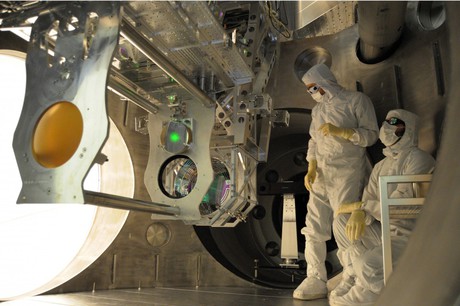The hunt for gravitational waves begins

The Advanced LIGO project has been officially opened in the United States. The project aims to complete the search for the last missing piece of Einstein’s general theory of relativity - gravitational waves.
Originally proposed by Einstein in 1915, gravitational waves are ripples in the fabric of space and time caused by the most violent events in the universe, such as supernovae or collisions between black holes. LIGO (the Laser Interferometer Gravitational-wave Observatories) - an identical pair of laboratories in opposite corners of the United States - aims to find these waves.
Each laboratory consists of two 4 km-long vacuum-pipes at right angles to each other, with mirrors suspended at either end. A laser beam is sent back and forth between the mirrors to form an interferometer. Originally built in the 1990s, only now do the laboratories have the sensitivity levels required to detect gravitational waves.
A complete redesign and replacement of the detectors has resulted in a tenfold improvement in sensitivity. A gravitational wave passing through the interferometer should momentarily move the mirrors at a frequency of about a kilohertz somewhere in the region of 10-19 of a metre (one ten-thousandth of the radius of a proton), which will be picked up by the laser system.
Australia is a partner in Advanced LIGO, with research groups from The Australian National University (ANU) and the University of Adelaide, supported by the Australian Research Council, contributing to its construction and commissioning. LIGO will ultimately be joined by detectors in Europe, Japan and India.
The team at ANU has developed a system which locks the laser beam to the 40 kg mirrors to ensure that infinitesimal movements caused by a passing gravitational wave are identified, while other small movements are nullified. The University of Adelaide group has meanwhile developed a system to correct for any deformation of the mirrors due to heat, a crucial factor with the stored laser power of the system approaching half a megawatt.
Professor Jesper Munch, the leader of the University of Adelaide research group, described Advanced LIGO as “the most sensitive detector ever created”.
“The technology required pushes the limit of all the components, including low noise detectors, high-power lasers, quantum effects and technology such as optical polishing, coatings and vacuum systems,” he said.
ANU’s Professor David McClelland, who leads the Australian LIGO team, said the discovery of gravitational waves will enable us to find things we can’t image.
“It’s like the moment when Galileo first turned a telescope towards the skies and started a new epoch of astronomy,” Professor McClelland said. “Here we shall begin a whole new and fundamentally different way of observing the universe.”
Colon cancer DNA in blood can guide chemo decisions
A simple blood test could change how doctors decide which patients with colon cancer need...
Non-invasive blood test helps rule out oesophageal cancer
Designed and developed in Australia, the PromarkerEso test is designed to offer a quick,...
Taste-based flu test enables rapid diagnosis
The diagnostic tool consists of the sensor molecule thymol and a virus-specific sugar building...





